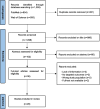How best to train kids in basic life support: a literature review
- PMID: 40474151
- PMCID: PMC12142893
- DOI: 10.1186/s12909-025-07331-3
How best to train kids in basic life support: a literature review
Abstract
Background: Bystander intervention is known to be the most important factor in the survival chain for out-of-hospital cardiac arrest. However, bystander cardiopulmonary resuscitation (CPR) rates remain low-mainly due to a lack of training. Implementing basic life support (BLS) training in schools is a key aspect of increasing bystander intervention. We reviewed the literature on BLS training methods for schoolchildren and sought to identify the methodological elements that appeared to be the most effective in terms of the acquisition and retention of knowledge, practical skills, and attitudinal skills.
Methods: We searched the MEDLINE database (via PubMed) for relevant articles published between from January 2015 to January 2022. Articles on BLS training in children were selected if the primary objective was determine the effectiveness of the training method(s) used.
Results: Of the 1,098 publications identified, 28 were selected and reviewed. Half of the studies had a randomized, controlled design, the study sample size ranged from 57 to 1,917. Hands-on practice was included in 26 of the 28 studies, and the main training session lasted for 75 to 120 min. Hands-on practice gave better results than no practice. Learning tools promoted acquisition, and refresher training sessions appeared to be of value.
Conclusions: The results of our literature review showed that the conventional training pattern used with adults (i.e. theory, demonstration, and practice) is applicable to children if all the components are adapted for this population. Further studies of the development and evaluation of BLS training for young children are required.
Keywords: BLS; Basic life support; CPR; Cardiac arrest; Cardiopulmonary resuscitation; Schoolchildren; Training.
© 2025. The Author(s).
Conflict of interest statement
Declarations. Ethics approval and consent to participate: This study and the French national cardiac arrest registry RéAC were approved by the French Advisory Committee on Information Processing in Health Research (CCTIRS (Paris, France)) on 10/14/2010 (number 10.326 Ter) and the French National Data Protection Commission (Commission nationale de l’informatique et des liberte´s (Paris, France): authorization number: 910946) on 04/06/2012. Consent for publication: Not applicable. Competing interests: The authors declare no competing interests.
References
-
- Gräsner JT, Lefering R, Koster RW, Masterson S, Böttiger BW, Herlitz J, et al. EuReCa ONE-27 Nations, ONE Europe, ONE Registry: a prospective one month analysis of out-of-hospital cardiac arrest outcomes in 27 countries in Europe. Resuscitation. 2016;105:188–95. 10.1016/j.resuscitation.2016.06.004. - PubMed
-
- Benjamin EJ, Virani SS, Callaway CW, Chamberlain AM, Chang AR, Cheng S, et al. Heart disease and stroke statistics-2018 update: a report from the american heart association. Circulation. 2018;137:e67-492. - PubMed
-
- Berdowski J, Berg RA, Tijssen JGP, Koster RW. Global incidences of out-of-hospital cardiac arrest and survival rates: systematic review of 67 prospective studies. Resuscitation. 2010;81:1479–87. 10.1016/j.resuscitation.2010.08.006. - PubMed
-
- Sasson C, Rogers MAM, Dahl J, Kellermann AL. Predictors of survival from out-of-hospital cardiac arrest: a systematic review and meta-analysis. Circ Cardiovasc Qual Outcomes. 2010;3:63–81. 10.1161/CIRCOUTCOMES.109.889576. - PubMed
-
- Weaver WD, Cobb LA, Hallstrom AP, Fahrenbruch C, Copass MK, Ray R. Factors influencing survival after out-of-hospital cardiac arrest. J Am Coll Cardiol. 1986;7:752–7. 10.1016/S0735-1097(86)80332-1. - PubMed
Publication types
MeSH terms
LinkOut - more resources
Full Text Sources
Medical


